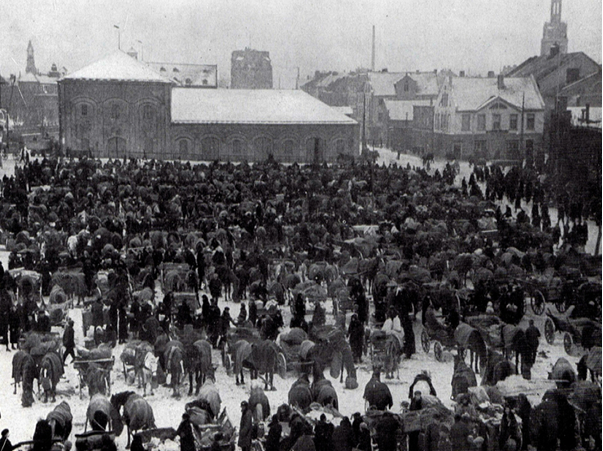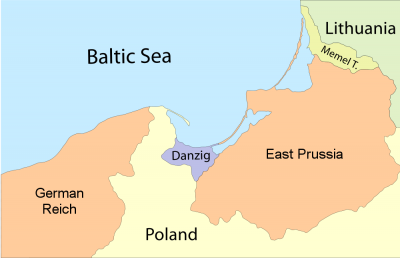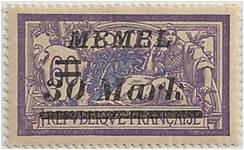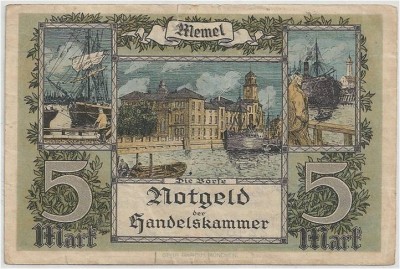ALBUM – view my French Administration of Memel album
TRANSITION CHART for the Baltics
Fast Facts
Region: Baltics
Group: Baltic Nations
Classification: League of Nations Administration (France)
Prior Regime: The German Empire
Key Dates:
1919, Jun – Treaty of Versailles
1920 – France assumed administration of Memel
1923, Jan 9 – Klaipėda Revolt
1923, Jan 19 – Memel annexed by Lithuania
Following Regime: Lithuanian Occupation of Klaipeda
Scott Catalogue: (Memel) #1-99, C1-C29
Pick Catalogue: (Memel) #1-9
History

Memel (Klaipeda) is a city on the Baltic at the mouth of the River Niemen which for centuries had considerable importance as a trading center. It was part of the Hanseatic League in the Middle Ages before being controlled by the Swedish. After the Napoleonic wars, it became part of Prussia. Memel and the surrounding area formed the eastern boundary of the German Empire and at the end of World War I, was ceded to the Allies who wanted to make it into a Free City. In 1920, according to the Treaty of Versailles, the German area north of the Memel river was given the status of Territoire de Memel under the administration of the Council of Ambassadors, and French troops were sent for protection. During the period of French administration, the idea of an independent State of “Memelland” grew in popularity among local inhabitants. This, however, was unacceptable to the government of the new Lithuania, who viewed the area as part of their own.
 On 9 January 1923, three years after the Versailles Treaty, Lithuania instigated the Klaipėda Revolt, mainly by militia that had entered from Lithuania. France at the same time had started the Occupation of the Ruhr in Germany, and the French administration in Memel did not take any significant counteractive measures against the rebels. Lithuanian Troops occupied Memel, renaming it Klaipeda, Lithuanian for the region. On 19 January, 1923 the territory was annexed by Lithuania, which was eventually confirmed by the Council of Ambassadors in 1924 and the League of Nations a year later..
On 9 January 1923, three years after the Versailles Treaty, Lithuania instigated the Klaipėda Revolt, mainly by militia that had entered from Lithuania. France at the same time had started the Occupation of the Ruhr in Germany, and the French administration in Memel did not take any significant counteractive measures against the rebels. Lithuanian Troops occupied Memel, renaming it Klaipeda, Lithuanian for the region. On 19 January, 1923 the territory was annexed by Lithuania, which was eventually confirmed by the Council of Ambassadors in 1924 and the League of Nations a year later..
Stamps
 ALBUM
ALBUM
During the French Administration of Memel, Both French and German stamps were overprinted and surcharged for use. Seventeen Germania design stamps were overprinted “MEMEL GEBIET” and were first issued 1 August, 1920. Additionally two types of French Stamps, the sower design and the “Merson Issue” named after the stamp desinger, were overprinted “MEMEL” and surcharged with Germany currency were first issued on 7 July, 1920. Both issues were used concurrently during the 3 year French Administration.
With the Klaipeda revolt, and occupation by Lithuanian troops, the Memel overprints were replaced with stamps marked “Klaipėda”, which is the Lithuanian name for the region.
Banknotes
 In 1922, a series of 9 colorful banknotes (notgeld) were issued in the region on an emergency basis to combat inflation. The notes were in 1/2, 1, 2, 5, 10, 20, 50, 75, 100 mark denominations.
In 1922, a series of 9 colorful banknotes (notgeld) were issued in the region on an emergency basis to combat inflation. The notes were in 1/2, 1, 2, 5, 10, 20, 50, 75, 100 mark denominations.
Links
Historical Article on Memelland from Preussens Gloria
Memel stamps at the Lithuanian Philately Blog




